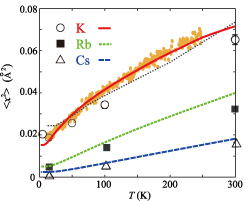Strong Coupling Superconductivity Mediated by Anharmonic Phonons in β-Pyrochlore Oxides
AOs2O6 (A = K, Rb, or Cs)
Tsunetsugu Group
In recent years, much attention has been shown for the effects of local anharmonic ion oscillations in a cage structure on thermodynamics and transport phenomena in filled-skutterudites and β-pyrochlore compounds. They have a crystal structure of connected cages each of which contains one cation oscillating around its center. When the cage size is much larger than the radius of the contained cation, the oscillation of this ion is dramatically enhanced in its amplitude and thus becomes anharmonic. Indeed, anomalously large oscillation amplitudes are observed in these compounds by neutron experiments. In β-pyrochlore oxides AOs2O6 (A = K, Rb, or Cs), A-cation is surrounded by an Os12O18 cage and its oscillation is found to be anharmonic particularly in KOs2O6, which can be understood by noting that the K-cation has the smallest size while the cage size is almost identical among the three members. Furthermore, high transition temperature of superconductivity is observed in KOs2O6 (Tc = 9.6 K) and Tc decreases with increasing cation size: 6.3 K for RbOs2O6 and 3.3 K for CsOs2O6. This variation of Tc related to the cation size is expected to be due to different anharmonicity of ion oscillations.

Fig.1. Temperature dependence of cation oscillation amplitude
Our group has recently performed a detailed quantitative analysis of the anharmonic A-cation oscillation and superconducting transition temperature in β-pyrochlore oxides [1] . We first examined local cation potential and then solve the three-dimensional Schrödinger equation for the cation quantum dynamics and calculated phonon propagator. It is important that the A-cation site has tetrahedral point group symmetry, and therefore the potential has a third order term, namely, a term proportional to xyz, where x, y, and z are the components of A-cation displacement from the equilibrium position. We chose the potential parameters so as to reproduce the experimental data of cation oscillation amplitude. Then, we applied the strong coupling theory of s-wave pairing combined with the obtained phonon propagator, and calculated Tc for the three compounds.
Figure1 shows the temperature dependence of cation oscillation amplitude <x2> for the three compounds compared with the experimental results. K-cation amplitude is much larger than Rb and Cs, and the temperature dependence differs even qualitatively; the curve is concave only for K. Our results well reproduce the experimental data, successfully capturing the genuine behavior. We also compare the temperature dependence of phonon density of states with the inelastic neutron scattering data, and confirmed the agreement. Thus, our phonon propagator is reliable to be used for calculating Tc.
The superconducting transition temperature Tc was calculated by setting the same electron-phonon coupling constant for the three compounds, including the additional contribution of higher-energy phonon observed in the neutron scattering experiments in order to make our calculation realistic. This additional contribution is determined from the calculation for the Cs-compound. The results are Tc = 10.5 K for K-, 5.7 K for Rb- and 3.4 K for Cs-compounds, respectively. These Tc values quantitatively agree with the experimental data and we find that the anharmonic phonons contribute up to 60 % of Tc for the K-compound, while much smaller for the other two.
To summarize, we have succeeded in the microscopic description of the anharmonic cation oscillations in β-pyrochlore compounds and reproduced the quantitatively correct values of their superconducting transition temperature Tc. We have also demonstrated that the low-energy anharmonic phonon indeed enhances Tc. Recently, enhancement of Tc in high pressure was reported and it is important to examine the change in phonon anharmonicity in order to understand this interesting behavior. We hope our results shed a new light on the physics of superconductivity mediated by anharmonic phonons.
References
- K. Hattori and H. Tsunetsugu, Phys. Rev. B 81, 134503 (2010).
